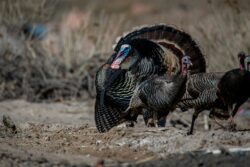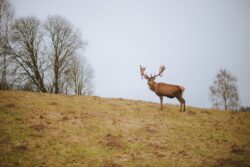Alberta’s Upland Game Bird Diversity
Alberta, with its vast and varied landscapes, is home to a rich diversity of upland game birds.
Among these, the Wild Turkey stands out as the largest upland game bird found in the province.
This distinction is based on comprehensive wildlife management plans and studies aimed at understanding and conserving Alberta’s upland game bird populations.
The Wild Turkey in Alberta
- Introduction and Habitat: The Wild Turkey, reintroduced and managed through careful wildlife conservation efforts, thrives in Alberta’s specific habitats that support its size and foraging needs.
- Size and Significance: As the largest upland game bird in Alberta, the Wild Turkey contributes to the province’s biodiversity and offers unique hunting opportunities. Its presence reflects successful wildlife management and habitat conservation practices.
Alberta’s Commitment to Upland Game Bird Conservation
The management of upland game birds in Alberta, including the Wild Turkey, involves:
- Habitat Conservation: Ensuring the preservation and restoration of natural habitats that support the diverse species of upland game birds in Alberta.
- Population Monitoring: Regular surveys and studies to monitor upland game bird populations, ensuring sustainable numbers that contribute to ecological balance and biodiversity.
- Hunting Regulations: Implementing and adjusting hunting regulations to maintain healthy populations of upland game birds, including setting seasons, limits, and protected areas to ensure the long-term sustainability of species like the Wild Turkey.
Understanding Upland Birds
Defining Upland Birds
Upland birds are a group of bird species primarily associated with terrestrial habitats, as opposed to wetlands or aquatic environments.
These birds are often found in areas such as grasslands, forests, and agricultural fields, where they forage for food, which mainly consists of seeds, insects, and other small invertebrates.
The term “upland” distinguishes their preferred habitats from those of waterfowl and other bird species that rely on aquatic ecosystems.
Characteristics of Upland Birds
- Habitat: Upland birds thrive in a variety of terrestrial landscapes, including open prairies, dense brush, and wooded areas. Their habitats are characterized by the availability of ground cover, which provides protection from predators and harsh weather conditions.
- Diet: These birds have a diverse diet that can include seeds, fruits, insects, and small vertebrates. The specific diet varies among species and is influenced by the habitat’s ecological conditions and seasonal availability of food sources.
- Behavior: Upland birds exhibit a range of behaviors, from ground foraging to short-distance flights. Many species are known for their distinctive calls and songs, which play a crucial role in communication and mating rituals.
Examples of Upland Birds
In Alberta, and more broadly in North America, common examples of upland birds include:
- Pheasants: Known for their colorful plumage and long tails, pheasants are a popular target for upland bird hunting.
- Grouse: This group includes several species, such as the ruffed grouse and sharp-tailed grouse, which are adapted to forested and prairie habitats, respectively.
- Quail: Small and ground-dwelling, quail species are often found in open areas with dense vegetation.
- Wild Turkey: As the largest upland game bird in Alberta, wild turkeys are notable for their size, distinctive appearance, and social behavior.
The Role of Upland Birds in Ecosystems
Upland birds play a significant role in their ecosystems, contributing to the control of insect populations, seed dispersal, and providing prey for predators.
Their presence and health are indicators of the overall biodiversity and ecological balance within their habitats.
Conservation efforts aimed at upland birds and their habitats not only protect these species but also support broader environmental health and sustainability.
FAQs: Upland Game Birds in Alberta
Q: Can you hunt Wild Turkeys in Alberta? A: Yes, Wild Turkeys can be hunted in Alberta, subject to specific regulations and seasons set by wildlife management authorities to ensure sustainable hunting practices.
Q: Why are Wild Turkeys significant to Alberta’s ecosystem? A: Wild Turkeys play a role in the ecosystem as part of the biodiversity in Alberta, contributing to the health of their habitats through their foraging activities and as a prey species for predators.
Q: How does Alberta manage its upland game bird populations? A: Alberta employs a comprehensive approach to wildlife management, including habitat conservation, population monitoring, and regulated hunting, to ensure the health and sustainability of upland game bird populations.
Alberta’s Rich Avian Tapestry
The presence of the Wild Turkey as the largest upland game bird in Alberta highlights the province’s rich avian diversity and the success of its wildlife conservation efforts.
Alberta’s landscapes provide a haven for a variety of upland game birds, each contributing to the ecological richness and outdoor heritage of the province.
Sources
- Alberta Environment and Parks: Offers detailed insights into the management plan for Wild Turkeys in Alberta, underscoring the efforts towards their conservation and the role of hunting in population management. Management Plan for Wild Turkeys in Alberta
- Alberta Professional Outfitters Society (APOS): Provides information on upland bird hunting in Alberta, highlighting the variety of species and the importance of sustainable hunting practices. Upland Birds – APOS
In Summary:
- The Wild Turkey is recognized as the largest upland game bird found in Alberta, showcasing the province’s diverse wildlife and successful conservation practices.
- Alberta’s approach to upland game bird management includes habitat conservation, population monitoring, and regulated hunting to ensure the sustainability of species like the Wild Turkey.
- The efforts to conserve and manage upland game bird populations reflect Alberta’s commitment to preserving its natural heritage and biodiversity for future generations.





